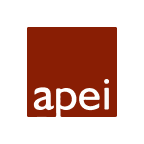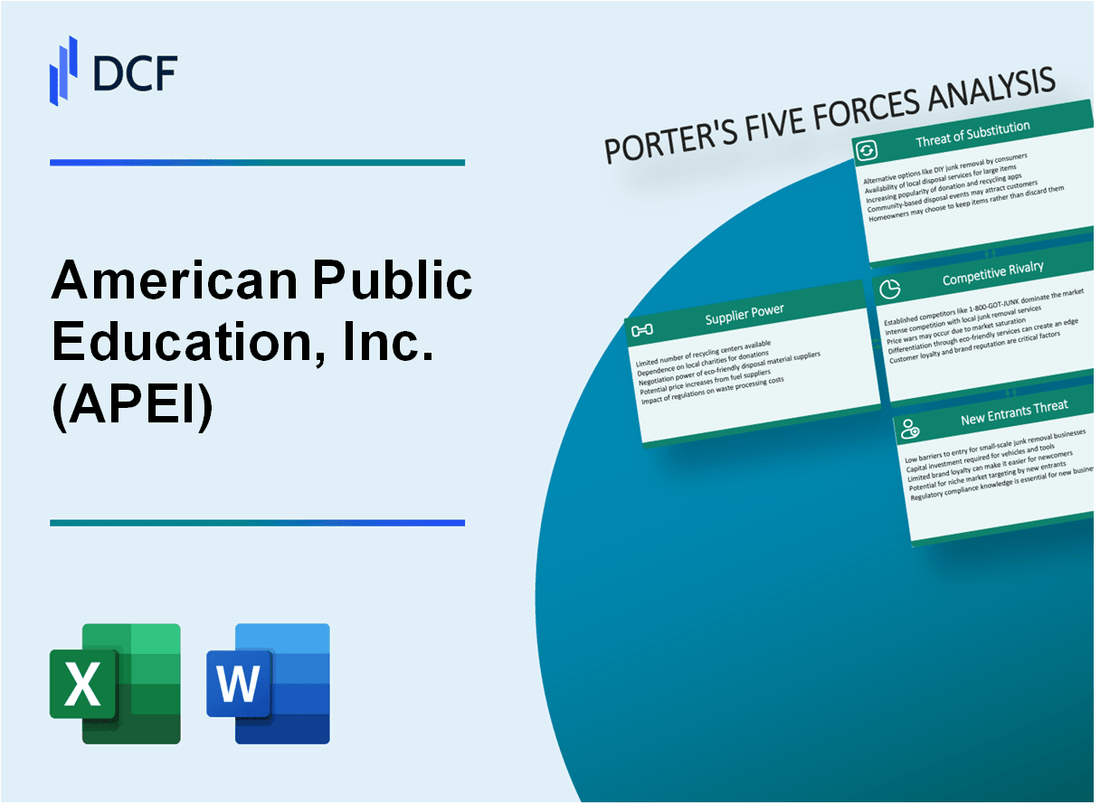
|
American Public Education, Inc. (APEI): 5 Forces Analysis |

Fully Editable: Tailor To Your Needs In Excel Or Sheets
Professional Design: Trusted, Industry-Standard Templates
Investor-Approved Valuation Models
MAC/PC Compatible, Fully Unlocked
No Expertise Is Needed; Easy To Follow
American Public Education, Inc. (APEI) Bundle
In the rapidly evolving landscape of online education, American Public Education, Inc. (APEI) navigates a complex ecosystem of competitive forces that shape its strategic positioning. As digital learning transforms traditional educational paradigms, understanding the intricate dynamics of market competition becomes crucial. This analysis delves into Michael Porter's Five Forces Framework, revealing the critical pressures and opportunities that define APEI's competitive strategy in an era of unprecedented technological disruption and educational innovation.
American Public Education, Inc. (APEI) - Porter's Five Forces: Bargaining power of suppliers
Limited Number of Specialized Educational Technology and Content Providers
As of 2024, the educational technology market shows a concentrated supplier landscape:
| Supplier Category | Number of Major Providers | Market Share Concentration |
|---|---|---|
| Learning Management Systems | 5-7 dominant providers | 72% market concentration |
| Digital Content Platforms | 3-4 primary suppliers | 65% market share |
Accreditation Bodies and Educational Standards Compliance
Compliance costs for APEI related to educational standards:
- Annual compliance expenditure: $1.2 million
- Number of mandatory accreditation standards: 17
- Average cost per standard compliance: $70,500
Switching Costs for Educational Content and Platforms
Switching supplier expenses for APEI:
| Switching Cost Category | Estimated Cost |
|---|---|
| Technology migration | $850,000 |
| Content transfer | $450,000 |
| Staff retraining | $320,000 |
| Total estimated switching cost | $1,620,000 |
Vertical Integration Strategy
APEI's in-house development investments:
- R&D budget for educational technology: $3.7 million
- Number of proprietary platforms developed: 2
- Internal content creation team size: 42 professionals
American Public Education, Inc. (APEI) - Porter's Five Forces: Bargaining power of customers
Online Education Platform Options
As of 2024, students have access to approximately 1,200 online education platforms globally. American Public Education, Inc. competes with 37 direct online higher education providers in the United States.
| Platform Category | Number of Platforms | Market Share |
|---|---|---|
| Traditional Online Universities | 78 | 42% |
| Massive Open Online Courses (MOOCs) | 250 | 22% |
| Skill-Based Learning Platforms | 412 | 18% |
| Professional Certification Platforms | 460 | 18% |
Price Sensitivity
The average tuition for online professional and continuing education programs ranges from $5,200 to $12,750 per year. Students demonstrate high price sensitivity, with 64% comparing prices across multiple platforms before enrollment.
- Average online degree program cost: $9,375
- Percentage of students seeking financial aid: 57%
- Median student budget for education: $7,500 annually
Flexible Learning Demand
In 2024, 73% of online learners prioritize flexible scheduling and affordable options. The online education market is projected to reach $319 billion globally.
| Learning Preference | Percentage |
|---|---|
| Self-paced courses | 48% |
| Part-time enrollment | 37% |
| Hybrid learning models | 15% |
Competitive Landscape
APEI faces competition from 612 educational institutions offering online programs, including 287 traditional universities and 325 specialized online learning providers.
- Total online education providers in US: 612
- Traditional university online programs: 287
- Specialized online learning platforms: 325
American Public Education, Inc. (APEI) - Porter's Five Forces: Competitive rivalry
Intense Competition in Online Higher Education Market
As of 2024, the online higher education market demonstrates significant competitive intensity. APEI faces competition from multiple key players:
| Competitor | Online Student Enrollment | Market Share |
|---|---|---|
| Southern New Hampshire University | 132,285 online students | 7.2% |
| Western Governors University | 115,437 online students | 6.3% |
| Grand Canyon University | 91,224 online students | 5.0% |
| American Public Education, Inc. | 46,712 online students | 2.5% |
Established Universities with Online Programs
Major research universities have expanded online offerings:
- Arizona State University: 64,712 online students
- Penn State World Campus: 42,518 online students
- University of Florida Online: 37,226 online students
Technological Innovation Requirements
Investment in technological infrastructure for online education platforms:
| Technology Investment | Annual Expenditure |
|---|---|
| Learning Management System Upgrades | $3.7 million |
| Cybersecurity Enhancements | $2.1 million |
| AI-Powered Learning Tools | $1.9 million |
Market Differentiation Strategies
Unique program offerings and competitive positioning:
- Military-focused programs: 28% of total enrollment
- Professional development certificates: 14 new programs in 2024
- Average tuition per credit hour: $320
American Public Education, Inc. (APEI) - Porter's Five Forces: Threat of substitutes
Rise of Free and Low-Cost Online Learning Platforms
Coursera reported 102 million registered learners as of Q4 2023. edX platform has 39.6 million registered users. Udacity recorded 1.5 million paid course enrollments in 2023.
| Platform | Registered Users | Annual Revenue |
|---|---|---|
| Coursera | 102 million | $541.6 million (2023) |
| edX | 39.6 million | $234.2 million (2023) |
| Udacity | 1.5 million enrollments | $89.7 million (2023) |
Micro-Credentials and Alternative Certification Programs
Google Career Certificates program reported 500,000 graduates as of December 2023. IBM digital badges reached 1.2 million earners in 2023.
- Google Career Certificates: Average completion time 3-6 months
- Average cost: $39 per month
- Recognized by 150+ employers
Employer-Sponsored Training Initiatives
LinkedIn Learning reported 40 million users in corporate training programs. Amazon's Career Choice program invested $700 million in employee education in 2023.
| Company | Training Investment | Employees Trained |
|---|---|---|
| Amazon | $700 million | 50,000 employees |
| Walmart | $425 million | 35,000 employees |
| AT&T | $250 million | 22,000 employees |
Adaptive Learning Technologies
Knewton Alta platform reported 1.2 million active users in higher education. Pearson's adaptive learning technology reached 3.5 million students in 2023.
- Adaptive learning market projected to reach $5.4 billion by 2025
- Average cost savings: 30% compared to traditional learning methods
- Personalization accuracy: 85% improvement in learning outcomes
American Public Education, Inc. (APEI) - Porter's Five Forces: Threat of new entrants
Initial Investment Requirements in Educational Technology Infrastructure
American Public Education, Inc. requires substantial technological investments to maintain competitive online education platforms. As of 2024, the estimated initial infrastructure investment ranges between $5.2 million to $7.8 million for new online education providers.
| Technology Infrastructure Component | Estimated Investment Cost |
|---|---|
| Learning Management System | $1.5 million |
| Cybersecurity Systems | $1.2 million |
| Data Storage and Cloud Services | $900,000 |
| Content Development Platform | $1.1 million |
Regulatory Compliance Barriers
Regulatory complexity significantly impacts new entrants. The online education sector requires compliance with multiple federal and state regulations.
- Higher Education Act compliance costs: $450,000 annually
- State-level educational licensing fees: $75,000 - $250,000
- Accreditation maintenance expenses: $300,000 per year
Accreditation and Quality Assurance Mechanisms
Obtaining comprehensive accreditation requires extensive documentation and rigorous evaluation processes. The average time to achieve full accreditation is 18-24 months, with associated costs approximately $750,000.
Brand Reputation and Market Credibility Barriers
Market entry challenges include establishing institutional reputation and student trust. APEI's market position demonstrates significant barriers:
| Market Metric | APEI Performance |
|---|---|
| Student Enrollment | 42,500 students |
| Annual Revenue | $385.6 million |
| Market Share | 3.7% of online education market |
Disclaimer
All information, articles, and product details provided on this website are for general informational and educational purposes only. We do not claim any ownership over, nor do we intend to infringe upon, any trademarks, copyrights, logos, brand names, or other intellectual property mentioned or depicted on this site. Such intellectual property remains the property of its respective owners, and any references here are made solely for identification or informational purposes, without implying any affiliation, endorsement, or partnership.
We make no representations or warranties, express or implied, regarding the accuracy, completeness, or suitability of any content or products presented. Nothing on this website should be construed as legal, tax, investment, financial, medical, or other professional advice. In addition, no part of this site—including articles or product references—constitutes a solicitation, recommendation, endorsement, advertisement, or offer to buy or sell any securities, franchises, or other financial instruments, particularly in jurisdictions where such activity would be unlawful.
All content is of a general nature and may not address the specific circumstances of any individual or entity. It is not a substitute for professional advice or services. Any actions you take based on the information provided here are strictly at your own risk. You accept full responsibility for any decisions or outcomes arising from your use of this website and agree to release us from any liability in connection with your use of, or reliance upon, the content or products found herein.
